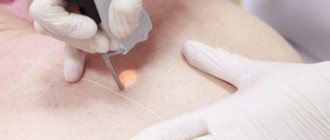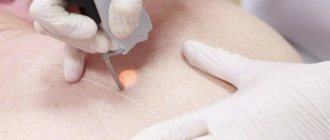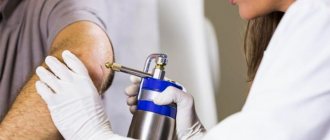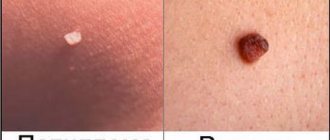The term papilloma refers to a group of various benign epithelial proliferations.
They can affect the appearance of the skin and the condition of the mucous membranes.
To remove papillomas, cauterization with various devices and medications is used.
Papilloma (condyloma) visually resembles a papilla attached to a narrow stalk.
The formation may be soft to the touch or have a dense structure.
In color - do not differ from the natural skin or be darker.
The localization of papillomas is varied.
Neoplasms affect the outer epidermis (facial skin, genitals, arms and legs).
So does the mucous membrane (vagina, cervix, colon, gastrointestinal tract).
In some cases, condylomas may form on the mucous membrane of the throat, which leads to difficulty breathing and voice disturbance.
The main cause of the formation of papillomas is HPV, a virus of the papillomavirus family, which includes about 170 strains.
HPV penetrates the skin or mucous membrane.
Mainly through small cracks or damage, and multiply inside cells.
HPV is transmitted by direct contact through affected areas of the skin or mucous membranes.
The most effective treatment for papillomas is their removal followed by therapy with antiviral and immunostimulating drugs.
There are a variety of methods for removing condylomas:
- laser
- surgical
- radio wave
- electric
- using low temperatures
Also, cauterization of papillomas can be carried out locally using medications (ointment or solution) that have a cytostatic effect.
Which therapy is suitable for the patient is decided on an individual basis.
The choice also depends on the nature of the warts and where they are located and how widely they have spread.
Cryodestruction of papillomas (cauterization with nitrogen)
Cryosurgery is used for a variety of benign, precancerous and malignant skin lesions.
Either as a primary or alternative form of treatment.
From a clinical point of view, the method is simple and safe.
The wide range of indications and relatively low cost of freezing make this method very popular in dermatological practice.
Cauterization of papillomas with nitrogen has a number of advantages:
- bloodless method (not accompanied by bleeding)
- does not provoke the development of scars and scar tissue
- in most cases no anesthesia is needed
- treatment can be single or multi-stage (repeated procedures are possible)
- low invasive method suitable for patients of all ages (most can be treated in outpatient clinics or day surgery centers)
- treatment of papillomas with nitrogen is safe and does not cause complications
- excellent cosmetic effect, minimal pain during the procedure
During cryodestruction, the active factor is liquid nitrogen.
The essence of the manipulation is to freeze the tumor at a temperature from -100°C to -180°C and then kill it.
Depending on the number of condylomas and their size, several procedures may be necessary.
In the first few hours after the manipulation, pronounced tissue swelling and redness are observed.
Over the next few days, symptoms become less severe.
After 7-10 days, complete death of the pathological tissue occurs.
Cryosurgery is not recommended for patients in the following cases:
- the presence of an acute infectious or inflammatory process (removal with nitrogen is carried out only after the disease has stopped)
- pathologies of internal organs that are under treatment
- hypersensitivity and intolerance to low temperatures
Disadvantages of cryodestruction:
- The skin takes a long time to recover; it will take about two weeks, sometimes more, until the tissue is completely healed
- nitrogen affects not only the pathologically altered area of the epithelium, but also the surrounding tissues, including
The downside is that a specialist cannot always determine the advisability of cryotherapy.
As a result, it is not possible to completely remove the formation and there is a need for surgical excision of the papilloma.
Cryodestruction is most widespread in gynecology.
Cauterization of papillomas in the vagina and cervix is considered the most gentle method of HPV treatment.
Does not have a negative effect on healthy areas of the mucosa.
Removal of tumors with nitrogen is the best option for nulliparous patients.
Radio wave excision of papillomas
Radio wave removal of papillomas is a method of non-contact surgery.
Based on the use of high frequency radio waves.
Radiosurgery is an atraumatic method of removing formations with simultaneous coagulation of soft tissues.
During the procedure, an optimal heat source with a low temperature of 4.0 MHz is used.
This technology allows you to simultaneously remove papillomas and coagulate surrounding tissue.
At the same time, preventing the development of bleeding, without causing burns, and also accelerating the regeneration process.
Cauterization of papilloma with radio waves has a number of advantages:
- Absence of pain during manipulation. Exposure of the epidermis to a high-frequency wave promotes coagulation of nerve fibers, blocking muscle spasms. Thus, the effect on sensitive receptors is eliminated, and the pain syndrome is relieved. If there is an increased pain threshold or psycho-emotional anxiety, the patient may be given an injection of an anesthetic drug.
- Minimal damage to non-pathologically altered tissues. The incision with a radio wave scalpel is carried out without pressure on the skin, thus, there is practically no impact on healthy tissue. In terms of this parameter, other methods of cauterization of condylomas are significantly inferior to the radio wave procedure.
- High regeneration capabilities. Simultaneously with the removal of the papilloma, the radio wave has a bacteriostatic effect on the wound, destroying all possible infectious microorganisms. For this reason, rapid healing of the epidermis and the absence of an inflammatory process are observed.
- No scar formation. When removing papillomas with a radio knife, the tumor is precisely and accurately cut off, while healthy tissue is not affected. This helps prevent the development of scar tissue and deep scars.
When radio wave treatment is contraindicated:
- the presence of acute inflammatory and infectious pathologies
- diseases of internal organs that are in the process of therapy
- the patient has a pacemaker (there is a risk of malfunctioning of the medical device)
If there is a contraindication to the methods described above, it is recommended to cauterize the papillomas with a laser.
The method is completely painless and does not require additional anesthesia.
The laser beam after cauterization of the papilloma does not provoke such consequences as the development of scar tissue or the formation of scars.
How is the procedure done?
Removing skin lesions using Foteka does not require special preparation.
The procedure takes place in several stages:
- Disinfection of the treatment area.
- Local anesthesia is administered - application or subcutaneous. After this, you need to wait about 5 minutes for it to take effect.
- The doctor removes the tumor with an electrode and smoothes the wound.
- The skin is re-disinfected with an antiseptic.
There are two ways to remove formations:
- Layer-by-layer burning of the tumor with smooth movements without going deep into the skin. This is the most common method; after removal there is no scar left or it can be visible from a very close distance.
- Cutting the tumor “at the root” in order to send it for histology. This is how a tumor should be removed if there is a suspicion of cancer. After the procedure, a small scar remains due to the traumatic nature of the manipulation.
Cauterization of papillomas with iodine
Cauterization of papillomas with iodine is the most accessible and cheapest method of eliminating formations.
Used in the presence of small growths.
As a rule, iodine is not used in its pure form, since it cannot have the desired effect on its own.
When removing small formations, 5% iodine is mixed with salicylic acid (2% solution).
In a ratio of 1:2 (one part iodine, two parts salicylic acid).
Apply baby cream or Vaseline to the area around the papilloma.
Next, using a cotton swab or ear swab, carefully apply the resulting mixture.
Salicylic acid has a softening effect, and iodine cauterizes and at the same time carries out coagulation.
Such treatment has no contraindications, except for the removal of papillomas that are located on the mucous membrane and individual intolerance to the components.
Cauterization of papillomas with iodine is relevant for neoplasms on the neck, face, and genital area that are not in contact with the mucous membranes.
But it is necessary to take into account that the procedure will not be able to completely eliminate the formation the first time.
As a rule, this therapy lasts for several weeks and even months.
Mole (nevus, pigmented nevus)
It is a clearly defined hyper-pigmented spot that may rise slightly above the surface of the skin. Color – from light to dark brown. Dimensions - from 1-2 mm to 1 cm. Nevi come in different types - papillomatous, blue, Ott's nevus, etc. Hairs can grow on a mole - this is considered a sign of a “benign” formation.
Small epidermal cysts (atheromas) look like a mole or papilloma - see photo below.
Cauterization of condylomas (papillomas) with potassium permanganate
Potassium permanganate is a potassium salt from the manganese subgroup (HMnO4).
The molecular formula of potassium permanganate is KMnO4.
At room temperature, the salt is present as a red-violet, shiny metallic crystalline solid.
The crystals are moderately soluble in water.
Even in low concentrations they lead to an intense violet color of the liquid, for which the permanganate anion is responsible.
Potassium permanganate solution is used as an astringent and disinfectant.
For external use on the skin, including mycoses, herpes zoster.
In emergency medicine, a 0.1% solution of potassium permanganate is used to lavage the stomach in case of poisoning due to ingestion of oxidized toxins.
Cauterization of papilloma with potassium permanganate is a popular method for removing tumors at home.
For the procedure, prepare a saturated dark purple solution.
They need to treat the formation several times a day until the papilloma completely disappears.
Under the influence of potassium permanganate, condylomas become dark in color, dry out and fall off.
The solution must be applied with extreme caution, avoiding contact with healthy tissue.
Cauterization of papillomas with potassium permanganate is also possible in intimate places.
But provided that the neoplasms do not come into contact with the mucous membranes.
Cauterization of papillomas with celandine is also popular.
To do this, use the juice of the plant, which is applied to the condyloma or wart.
For small growths, celandine is effective.
But treatment in this way can take several months.
As an alternative to the plant, you can use Supercelandine to cauterize papillomas.
This is an extract sold in any pharmacy.
Cauterization of papillomas at home should be carried out only after consultation with a doctor.
Types of tumors caused by HPV
Not all clinical manifestations of papillomatosis are the same. Today, about 90 HPV strains have been typed and correlated with certain types of neoplasms. Based on the external manifestations of the disease, the following types of papillomas are distinguished:
- plantar papillomas, often called warts;
- simple, or vulgar, papillomas;
- flat papillomas;
- genital warts;
- filamentous papillomas.
Even a doctor cannot always make an accurate diagnosis based on appearance
Plantar warts
As the name suggests, plantar warts form on the skin of the feet and are characterized by internal growth, which distinguishes them from other types of neoplasms. They are usually solitary, but if left untreated they can reach impressive sizes, causing considerable discomfort.
Vulgar papillomas
Vulgar papillomas are also often called warts in everyday life. They grow from a small tubercle, gradually enlarging and darkening due to keratinization, and can merge with each other into formations of an indeterminate shape. Papillomas of this type are most often localized on the skin of the hands, less often on the knees, face, neck, and back. Like plantar pain, they can go away on their own.
Flat papillomas
Flat papillomas rise slightly above the skin, and their surface has a nodular structure. These neoplasms are not subject to keratinization (keratinization) of the surface, so they usually retain the color of healthy tissue or become slightly darker. They can appear on the face in the eye area and on the chin, as well as on the lower legs, arms, and back. A common symptom of vulgar papillomas is itching. Such neoplasms do not go away on their own, and an accurate diagnosis must be made by a doctor.
Condylomas acuminata
Genital warts are similar in appearance to cauliflower. Single neoplasms grow on a thin stalk, gradually merging with each other into large growths. Condylomas are localized in the anogenital area:
- on the external and internal genital organs;
- outside and inside the anus;
- in the perianal fold;
- in the urethra and bladder.
These neoplasms are precancerous and therefore must be removed, followed by subsequent therapy based on test results. Suffice it to say that in almost 80% of cases, cervical cancer is detected by this type of human papillomavirus.
Filiform papillomas
Filiform papillomas, otherwise called acrochords, grow on a thin stalk, which makes them easy to accidentally tear off, and are predominantly single, less often found in groups. Their main locations are the face in the area of the eyes and nose, inguinal folds, axillary areas and under the breasts in women. They usually have an oblong, elastic shape without keratinization. Rubbing with clothing can cause discomfort and damage. Acrochords cause mainly aesthetic discomfort and are susceptible to malignancy in rare cases.
An accurate diagnosis can be established using laboratory methods for studying tumors
Pharmaceutical preparations for cauterization of papillomas
In the treatment of papillomas, in particular genital ones, it is important that both partners undergo therapy.
Otherwise, there is a risk of continuous cross-infection.
There is no “best” treatment for genital warts.
Therapy depends on the location and volume of papillomas, as well as on the preference of the doctor and, of course, also on the request of the patient.
The following effective treatment options are available to treat genital warts:
- topical medications such as creams, ointments or solutions
- surgical removal (coagulation, radio wave, nitrogen cauterization)
Podophyllotoxin cream or solution for cauterizing papillomas
Podophyllotoxinum is a medicine obtained from the root of Podophyllum thyroid.
More often it can be found on sale in the form of a cream for external use.
The drug is applied to papillomas twice a day for three days, followed by a four-day break.
If the procedure does not give the desired result, the manipulation can be repeated after four to five days.
This cycle of procedures can be repeated 2-3 times, but no more than four.
Podophyllotoxin is especially recommended for genital warts that have not yet been treated.
However, for larger papillomas, the size of which is 2 cm or more, podophyllotoxin is not suitable, since the maximum daily dose is 0.5 mg of the substance.
Additionally, Podophyllotoxin should not be used to treat genital warts located in the vagina or anus.
About half of the patients using the subphyllotoxin preparation noted a slight burning sensation.
Redness of the skin may occur as a side effect.
Podophyllotoxin is a toxin that blocks the division of pathological cells.
Therefore, it is strictly prohibited for the treatment of children, pregnant and lactating women.
Podophyllotoxin, a product for cauterizing papillomas, can be purchased at a pharmacy without a doctor's prescription.
Laser coagulation
The modern non-contact method of removing tumors using a laser has become widespread not so long ago. Experts say that it is absolutely painless and low-traumatic, because... infected tissues evaporate without harming healthy ones. The procedure takes a few minutes, and the rehabilitation period lasts 2 weeks, during which you should refrain from swimming in the pool and open water, and avoid temperature changes and the sun.
The method can cause side effects such as prolonged skin redness and swelling; in case of thyroid problems, keloid scars can form. There are many contraindications for this type of treatment:
- diabetes;
- acute inflammatory processes;
- epilepsy;
- disorders of the endocrine and immune systems;
- photoderomatosis;
- thrombocytopenia and others.
According to patients, the procedure is very unpleasant and painful, and during the process “you can smell the smell of burnt meat.” In addition, healing takes a long time and relapses are possible.
Trichloroacetic acid for cauterization of papillomas
Trichloroacetic acid is a liquid for cauterizing papillomas.
Stops the development of infected cells and prevents their further reproduction.
Trichloroacetic acid is applied by a doctor with a cotton swab to warts, papillomas/condylomas.
This treatment method is suitable for small, soft genital warts in the mucous membrane area (in the vagina).
Among the disadvantages of the method, it is worth noting burning and pain after applying the solution.
The advantage is the elimination of formations without tissue scarring.
Acid can only be used in very small quantities.
Excessive use requires neutralization with sodium bicarbonate.
Due to the potentially high risk of misuse, trichloroacetic acid should only be used by a physician in an outpatient setting.
Today, this method of therapy is rarely used; it has been replaced by more modern and gentle therapeutic methods.
An analogue of trichloroacetic acid is Solkovagin, which is also used to cauterize papillomas and warts.
The second, more expensive drug is Solcoderm, which can cauterize papillomas in intimate places.
Imiquimod cream for cauterization of papillomas
Imiquimod does not have a direct antiviral effect.
The cream modifies the immune response by activating messenger substances.
Such as interferons and cytokines, which play a role in cell communication and can influence cell function.
The product can also be found under the name Keravort.
Local therapy is carried out three times a week, the drug is applied to the papilloma before bedtime.
The maximum duration of use of the drug is 4 months.
The advantage of Imiquimod cream is the low incidence of recurrent genital warts (less than 20% as a result of a sustained immune response).
Imiquimod should not be used for genital papillomas in the vagina, cervix, lining of the glans penis or anus.









